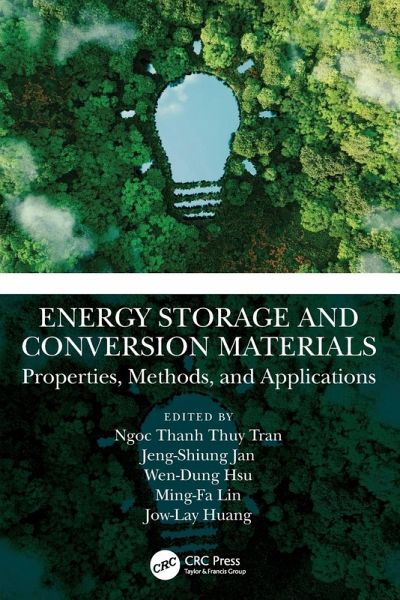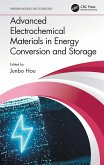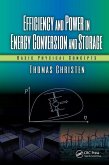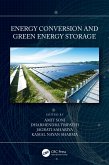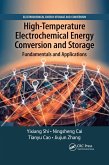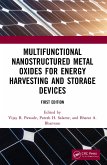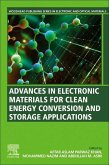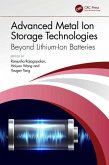Energy Storage and Conversion Materials
Properties, Methods, and Applications
Herausgeber: Jan, Jeng-Shiung; Hsu, Wen-Dung; Tran, Ngoc Thanh Thuy; Lin, Ming-Fa; Huang, Jow-Lay
Energy Storage and Conversion Materials
Properties, Methods, and Applications
Herausgeber: Jan, Jeng-Shiung; Hsu, Wen-Dung; Tran, Ngoc Thanh Thuy; Lin, Ming-Fa; Huang, Jow-Lay
- Broschiertes Buch
- Merkliste
- Auf die Merkliste
- Bewerten Bewerten
- Teilen
- Produkt teilen
- Produkterinnerung
- Produkterinnerung
This book explores energy storage and conversion materials, covering mainstream theoretical and experimental studies and applications. It investigates properties of rechargeable batteries, supercapacitors, solar cells, and fuel cells, theoretical simulations, machine learning, high-resolution experimental measurements, and device performance.
Andere Kunden interessierten sich auch für
![Advanced Electrochemical Materials in Energy Conversion and Storage Advanced Electrochemical Materials in Energy Conversion and Storage]() Advanced Electrochemical Materials in Energy Conversion and Storage178,99 €
Advanced Electrochemical Materials in Energy Conversion and Storage178,99 €![Efficiency and Power in Energy Conversion and Storage Efficiency and Power in Energy Conversion and Storage]() Thomas Christen (Switzerland ABB Switzerland Ltd.)Efficiency and Power in Energy Conversion and Storage63,99 €
Thomas Christen (Switzerland ABB Switzerland Ltd.)Efficiency and Power in Energy Conversion and Storage63,99 €![Energy Conversion and Green Energy Storage Energy Conversion and Green Energy Storage]() Energy Conversion and Green Energy Storage157,99 €
Energy Conversion and Green Energy Storage157,99 €![High-Temperature Electrochemical Energy Conversion and Storage High-Temperature Electrochemical Energy Conversion and Storage]() Yixiang ShiHigh-Temperature Electrochemical Energy Conversion and Storage87,99 €
Yixiang ShiHigh-Temperature Electrochemical Energy Conversion and Storage87,99 €![Multifunctional Nanostructured Metal Oxides for Energy Harvesting and Storage Devices Multifunctional Nanostructured Metal Oxides for Energy Harvesting and Storage Devices]() Multifunctional Nanostructured Metal Oxides for Energy Harvesting and Storage Devices57,99 €
Multifunctional Nanostructured Metal Oxides for Energy Harvesting and Storage Devices57,99 €![Advances in Electronic Materials for Clean Energy Conversion and Storage Applications Advances in Electronic Materials for Clean Energy Conversion and Storage Applications]() Advances in Electronic Materials for Clean Energy Conversion and Storage Applications294,99 €
Advances in Electronic Materials for Clean Energy Conversion and Storage Applications294,99 €![Advanced Metal Ion Storage Technologies Advanced Metal Ion Storage Technologies]() Advanced Metal Ion Storage Technologies77,99 €
Advanced Metal Ion Storage Technologies77,99 €-
-
-
This book explores energy storage and conversion materials, covering mainstream theoretical and experimental studies and applications. It investigates properties of rechargeable batteries, supercapacitors, solar cells, and fuel cells, theoretical simulations, machine learning, high-resolution experimental measurements, and device performance.
Hinweis: Dieser Artikel kann nur an eine deutsche Lieferadresse ausgeliefert werden.
Hinweis: Dieser Artikel kann nur an eine deutsche Lieferadresse ausgeliefert werden.
Produktdetails
- Produktdetails
- Verlag: Taylor & Francis Ltd
- Seitenzahl: 384
- Erscheinungstermin: 19. Dezember 2024
- Englisch
- Abmessung: 158mm x 235mm x 23mm
- Gewicht: 546g
- ISBN-13: 9781032434223
- ISBN-10: 1032434228
- Artikelnr.: 72109578
- Herstellerkennzeichnung
- Libri GmbH
- Europaallee 1
- 36244 Bad Hersfeld
- 06621 890
- Verlag: Taylor & Francis Ltd
- Seitenzahl: 384
- Erscheinungstermin: 19. Dezember 2024
- Englisch
- Abmessung: 158mm x 235mm x 23mm
- Gewicht: 546g
- ISBN-13: 9781032434223
- ISBN-10: 1032434228
- Artikelnr.: 72109578
- Herstellerkennzeichnung
- Libri GmbH
- Europaallee 1
- 36244 Bad Hersfeld
- 06621 890
Ngoc Thanh Thuy Tran obtained her Ph.D. in Physics in 2017 from the National Cheng Kung University (NCKU), Taiwan. Afterward, she began to work as a postdoctoral researcher and then an assistant researcher at Hierarchical Green-Energy Materials (Hi-GEM) Research Center, NCKU. Her scientific interest is focused on the fundamental (electronic, magnetic, and thermodynamic) properties of 2D materials and rechargeable battery materials by means of the first-principles calculations. Jeng-Shiung Jan is a professor in the Department of Chemical Engineering, NCKU, Taiwan. He received his PhD in Chemical Engineering in 2006 from Texas A&M University and conducted postdoctoral research at Georgia Institute of Technology. His current research focuses on studying the synthesis of functional polymers and nanomaterials. He received several awards, including Outstanding Professor in Academic Research from LCY Education Foundation and Lai Zaide Professor Award. Wen-Dung Hsu is a professor in the Department of Materials Science and Engineering, NCKU, Taiwan. His expertise is utilizing computational materials science methods including first-principle calculations, molecular dynamics simulations, Monte-Carlo methods, and finite-element methods to study materials issues. His research interests are mechanical properties of materials from atomic to macro scale, lithium-ion battery, solid-oxide fuel cell, ferroelectrics, solid catalyst design for biodiesel, and processing design for single-crystal growth. Ming-Fa Lin is a distinguished professor in the Department of Physics, NCKU, Taiwan. He received his PhD in physics in 1993 from the National Tsing-Hua University, Taiwan. His main scientific interests focus on essential properties of carbon-related materials and low-dimensional systems. He is a member of American Physical Society, American Chemical Society, and the Physical Society of Republic of China (Taiwan). Jow-Lay Huang is working as a chair professor in the Department of Materials Science and Engineering, NCKU, Taiwan. He is the director of the Hierarchical Green-Energy Materials (Hi-GEM) Research Center, NCKU. He received his PhD in Materials Science and Engineering in 1983 from University of Utah. His research interest includes the fabrication, development and application of ceramic nanocomposites, piezo-phototronic thin films for photodetector devices, piezoelectric thin films for high frequency devices, metal oxide/graphene and SiCx nanocomposites as anode materials for lithium-ion battery, and 2D nanocrystal materials for photoelectrochemical application.
1. Introduction and Methods. 2. Molecular Dynamics Simulation of Amorphous
Silicon Anode in Li-Ion Batteries. 3. Rich Intercalations in Graphite
Magnesium Compounds. 4. Na-Intercalation Compounds and Na-Ion Batteries. 5.
Electronic Properties of LiLaTiO4 Compound. 6. Electronic Properties of
Li2S-Si Heterojunction. 7. Electronic and Magnetic Properties of LiMnO2
Compound. 8. Surface Property of High-Voltage Cathode LiNiPO 4 in
Lithium-Ion Batteries: A First-Principles Study. 9. Introduction to Machine
Learning Method and Its Applications in Li-Ion Batteries. 10. SnOx
(x=0,1,2) and Mo Doped SnO2 Nanocomposite as Possible Anode Materials in
Lithium-Ion Battery. 11. Polymer Electrolytes Based on Ionic Liquid and
Poly(Ethylene Glycol) via in-situ Photopolymerization for Lithium-Ion
Batteries. 12. Synthesis of Multiporous Carbons with Biomaterials for
Applications in Supercapacitors and Capacitive Deionization. 13.
Low-Dimensional Heterostructure-Based Solar Cells. 14. Towards High
Performance Indoor Dye-Sensitized Photovoltaics: A Review of Electrodes and
Electrolytes Development. 15. Progress and Prospects of
Intermediate-Temperature Solid Oxide Fuel Cells. 16. Concluding Remarks.
17. Energy Resources and Challenges. 18. Problems Under Classical and
Quantum Pictures
Silicon Anode in Li-Ion Batteries. 3. Rich Intercalations in Graphite
Magnesium Compounds. 4. Na-Intercalation Compounds and Na-Ion Batteries. 5.
Electronic Properties of LiLaTiO4 Compound. 6. Electronic Properties of
Li2S-Si Heterojunction. 7. Electronic and Magnetic Properties of LiMnO2
Compound. 8. Surface Property of High-Voltage Cathode LiNiPO 4 in
Lithium-Ion Batteries: A First-Principles Study. 9. Introduction to Machine
Learning Method and Its Applications in Li-Ion Batteries. 10. SnOx
(x=0,1,2) and Mo Doped SnO2 Nanocomposite as Possible Anode Materials in
Lithium-Ion Battery. 11. Polymer Electrolytes Based on Ionic Liquid and
Poly(Ethylene Glycol) via in-situ Photopolymerization for Lithium-Ion
Batteries. 12. Synthesis of Multiporous Carbons with Biomaterials for
Applications in Supercapacitors and Capacitive Deionization. 13.
Low-Dimensional Heterostructure-Based Solar Cells. 14. Towards High
Performance Indoor Dye-Sensitized Photovoltaics: A Review of Electrodes and
Electrolytes Development. 15. Progress and Prospects of
Intermediate-Temperature Solid Oxide Fuel Cells. 16. Concluding Remarks.
17. Energy Resources and Challenges. 18. Problems Under Classical and
Quantum Pictures
1. Introduction and Methods. 2. Molecular Dynamics Simulation of Amorphous
Silicon Anode in Li-Ion Batteries. 3. Rich Intercalations in Graphite
Magnesium Compounds. 4. Na-Intercalation Compounds and Na-Ion Batteries. 5.
Electronic Properties of LiLaTiO4 Compound. 6. Electronic Properties of
Li2S-Si Heterojunction. 7. Electronic and Magnetic Properties of LiMnO2
Compound. 8. Surface Property of High-Voltage Cathode LiNiPO 4 in
Lithium-Ion Batteries: A First-Principles Study. 9. Introduction to Machine
Learning Method and Its Applications in Li-Ion Batteries. 10. SnOx
(x=0,1,2) and Mo Doped SnO2 Nanocomposite as Possible Anode Materials in
Lithium-Ion Battery. 11. Polymer Electrolytes Based on Ionic Liquid and
Poly(Ethylene Glycol) via in-situ Photopolymerization for Lithium-Ion
Batteries. 12. Synthesis of Multiporous Carbons with Biomaterials for
Applications in Supercapacitors and Capacitive Deionization. 13.
Low-Dimensional Heterostructure-Based Solar Cells. 14. Towards High
Performance Indoor Dye-Sensitized Photovoltaics: A Review of Electrodes and
Electrolytes Development. 15. Progress and Prospects of
Intermediate-Temperature Solid Oxide Fuel Cells. 16. Concluding Remarks.
17. Energy Resources and Challenges. 18. Problems Under Classical and
Quantum Pictures
Silicon Anode in Li-Ion Batteries. 3. Rich Intercalations in Graphite
Magnesium Compounds. 4. Na-Intercalation Compounds and Na-Ion Batteries. 5.
Electronic Properties of LiLaTiO4 Compound. 6. Electronic Properties of
Li2S-Si Heterojunction. 7. Electronic and Magnetic Properties of LiMnO2
Compound. 8. Surface Property of High-Voltage Cathode LiNiPO 4 in
Lithium-Ion Batteries: A First-Principles Study. 9. Introduction to Machine
Learning Method and Its Applications in Li-Ion Batteries. 10. SnOx
(x=0,1,2) and Mo Doped SnO2 Nanocomposite as Possible Anode Materials in
Lithium-Ion Battery. 11. Polymer Electrolytes Based on Ionic Liquid and
Poly(Ethylene Glycol) via in-situ Photopolymerization for Lithium-Ion
Batteries. 12. Synthesis of Multiporous Carbons with Biomaterials for
Applications in Supercapacitors and Capacitive Deionization. 13.
Low-Dimensional Heterostructure-Based Solar Cells. 14. Towards High
Performance Indoor Dye-Sensitized Photovoltaics: A Review of Electrodes and
Electrolytes Development. 15. Progress and Prospects of
Intermediate-Temperature Solid Oxide Fuel Cells. 16. Concluding Remarks.
17. Energy Resources and Challenges. 18. Problems Under Classical and
Quantum Pictures

